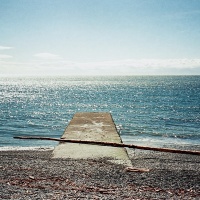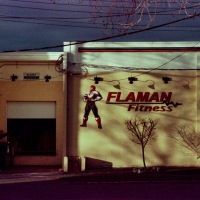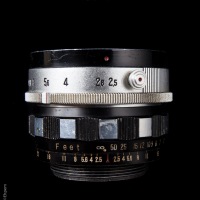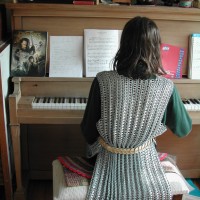Testing the Ansco Color Clipper
A few days ago I wrote about repairing an Ansco Color Clipper that I found in a thrift store (see that post here). Today I show some photos from the first roll of film. As I described before the camera has one shutter speed, measured at 1/30th, and two f-stops labelled B&W and Color. I infer that B&W is f/16, or possibly f/11 and Color is f/32 or possibly f/22.
To test the camera I used a roll of Ilford Delta 100 that expired in May 2008. I chose that film because I had it, and because I figured that it might be best shot at ISO50, after the rule of thumb that old film generally needs a 1 EV adjustment per decade of expiry. Since the camera was designed to use either 32 or 125 ISO film I figured that I would land solidly within that range with this film and would be more likely to get useable images from the camera.
I mostly took pairs of shots, one on the B&W setting and one on the Color setting. I used the scale focus and for nearest focus roughly measured 4 ft (ie for the shot above). I wanted to be sure that I had assemble the lens so that the scale labels are still accurate.
So, what did I learn?
- First, the camera works well enough to use.
- The focus scale seems to be accurate, or at least accurate enough.
- There does seem to be about a 2 stop difference between the f-stops, at least looking at the negatives. The commercial scans have averaged things a bit so the exposures look more similar than they do on the negative.
- I think this camera should work well with modern films rated for 50 to 100 ISO, and probably 200 ISO for C41 films. And 400 ISO in cloudy conditions.
- The main takeaway from my test though is that the lens performs better on the B&W setting (ca f/32) than on the Colour setting (ca f/16). This is more than just because there is a greater depth of field, the image is overall sharper even when there is plenty of subject at different distances to see what was the focal distance. I guess that at f/32 the center (and better part) of the lens is being used. You can see these differences by looking at the pairs in the gallery below.
So, in conclusion, unless there is a need for a bit of exposure compensation and sharp focus is not critical, then this lens should normally be used in the B&W setting, and thus probably should be used with ca 100 ISO film in bright daylight, and probably comfortably with 200 ISO C41 film as well. There is quite a lot of film that works satisfactorily between 50 and 400 ISO without any adjustment to developing protocols, and these are the films I should seek to use.
To view images in detail click on any image and then click on the arrows or swipe to navigate.
- ~f/32 (B&W), focus at 4 ft
- ~f/16 (Color), focus at 4 ft
- ~f/32 (B&W), focus at 17 ft
- ~f/16 (Color), focus at 17 ft
- ~f/32 (B&W), focus at 4 ft
- ~f/16 (Color), focus at 4 ft
- ~f/32 (B&W), focus at 9 ft
- ~f/16 (Color), focus at 9 ft
- f/16 (Color), focus at 12 ft





















